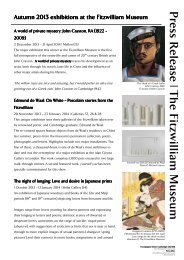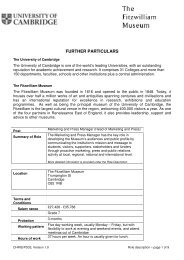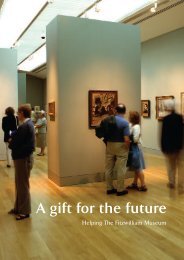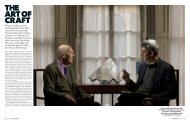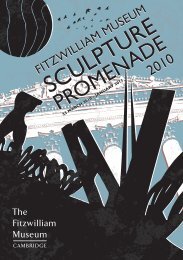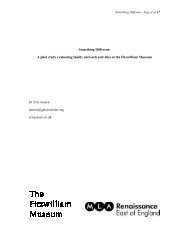The Fitzwilliam Museum - University of Cambridge
The Fitzwilliam Museum - University of Cambridge
The Fitzwilliam Museum - University of Cambridge
Create successful ePaper yourself
Turn your PDF publications into a flip-book with our unique Google optimized e-Paper software.
<strong>The</strong> Head <strong>of</strong> John the Baptist on a Dish<br />
English, probably Nottingham, 15th century<br />
Alabaster, with remnants <strong>of</strong><br />
painting and gilding.<br />
H. 29 x W. 23.5 cm<br />
M.2–2004<br />
Purchased from the Boscawen<br />
Fund and with grants from the<br />
National Art Collections Fund<br />
and the MLA/V&A Purchase<br />
Grant Fund.<br />
This powerful image <strong>of</strong> St John the<br />
Baptist's head on a dish supported by<br />
angels would have provided a focus for<br />
the private devotions <strong>of</strong> its owner, and<br />
may have been housed in a wooden case,<br />
whose painted doors were opened while<br />
he or she was at prayer. Alabaster<br />
carvings were an important aspect <strong>of</strong> late<br />
medieval English art, and were exported<br />
widely to the Continent. Much <strong>of</strong> the<br />
best alabaster was quarried in the area<br />
between Tutbury in Staffordshire and<br />
Chellaston near Derby, and Nottingham,<br />
some 15 to 20 miles further east, became<br />
a major centre for the production <strong>of</strong><br />
religious figures, altarpieces, and panels.<br />
Local documents contain many records <strong>of</strong><br />
the alabasterers' activity, including<br />
references to panels showing the head <strong>of</strong><br />
St John the Baptist, which seems to have<br />
been a Nottingham speciality in the late<br />
fifteenth and early sixteenth centuries.<br />
49<br />
Major Acquisitions



